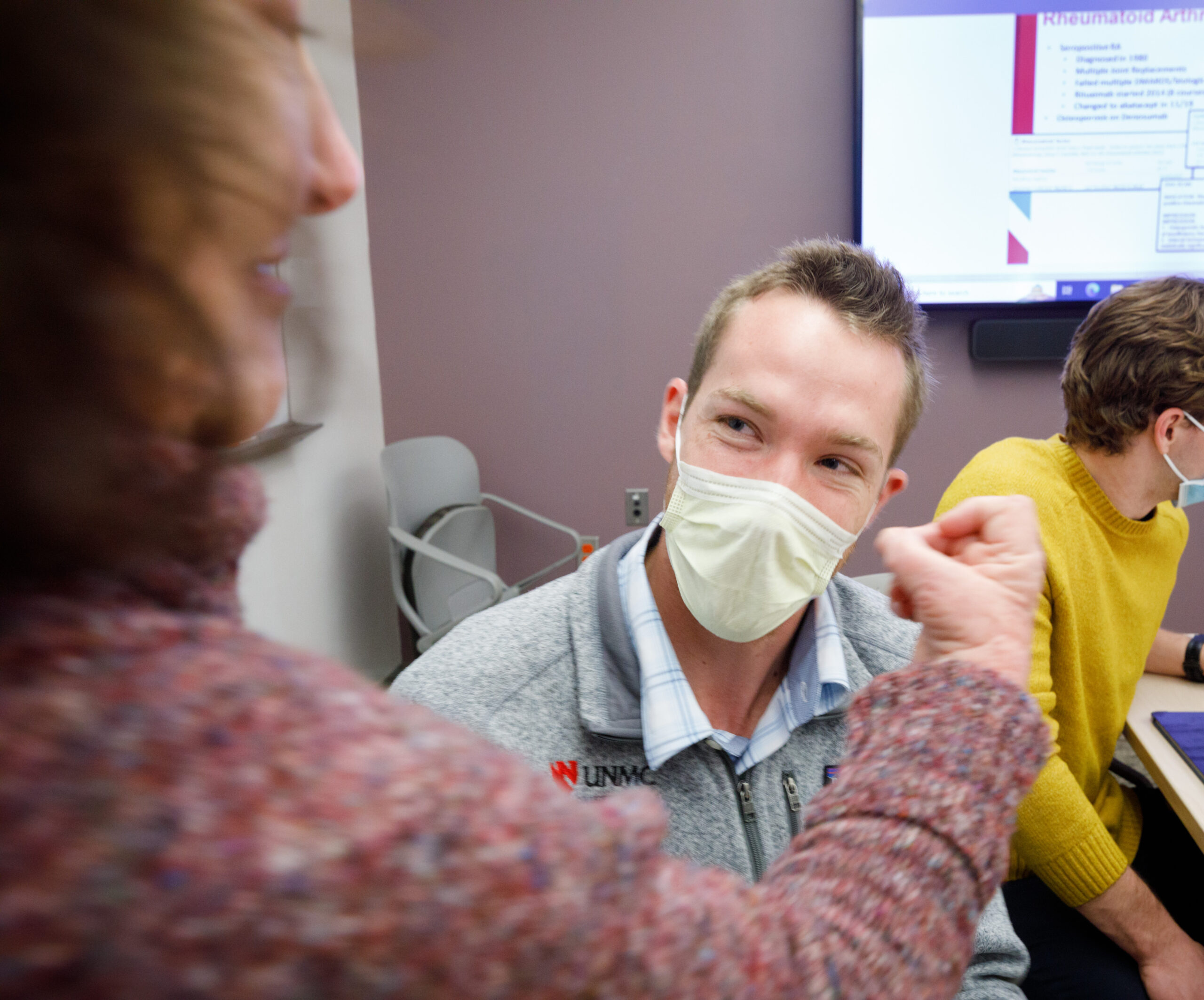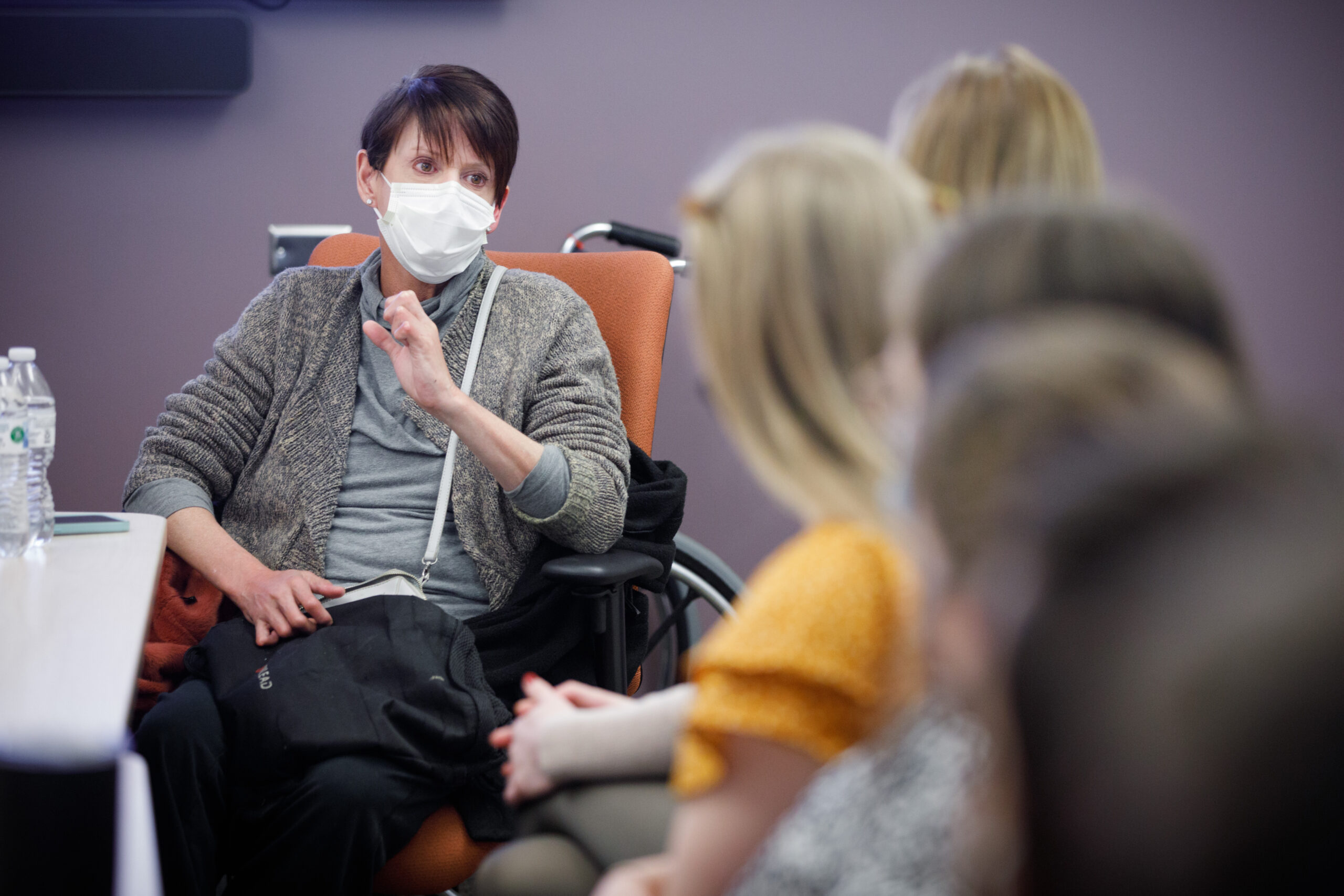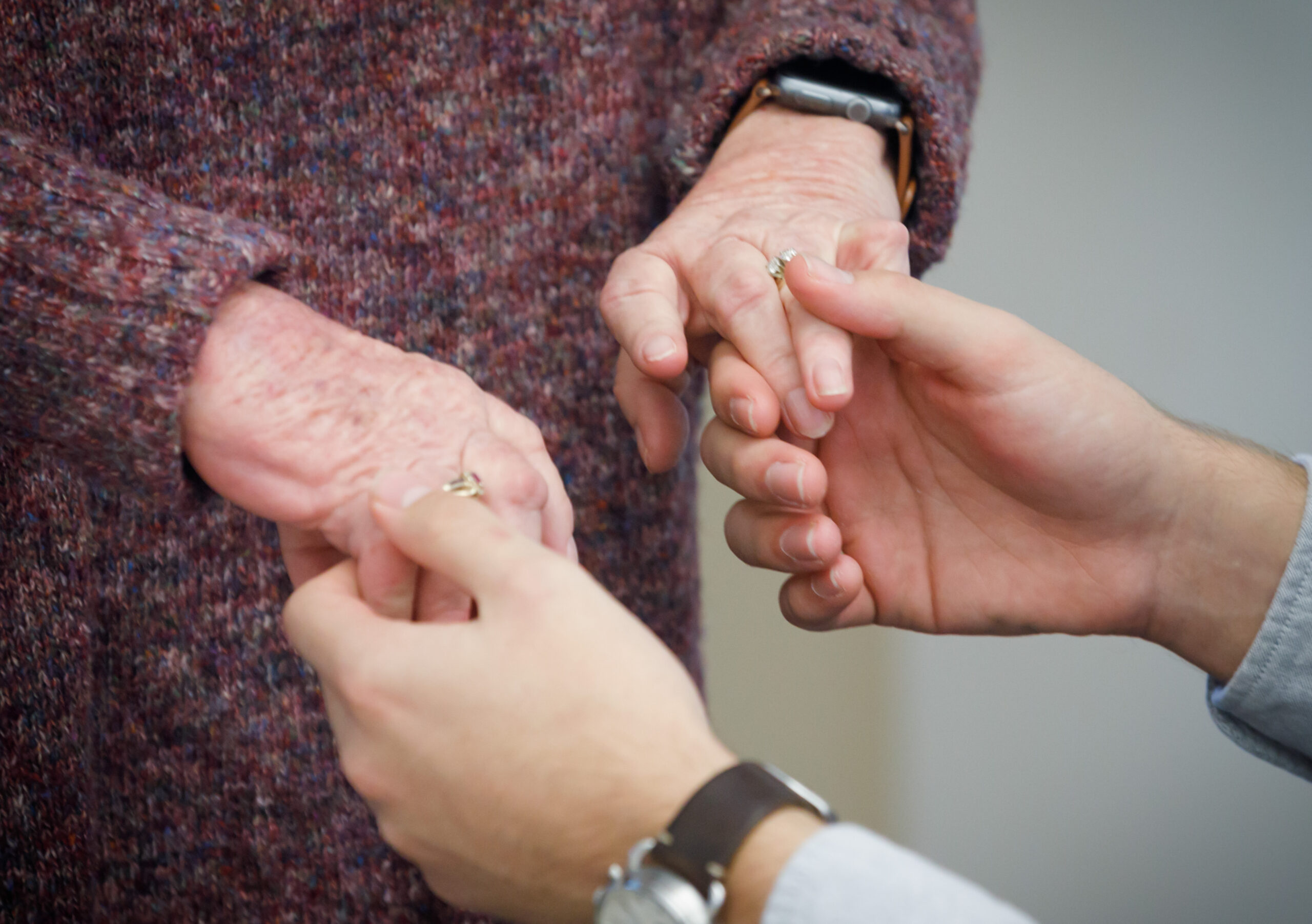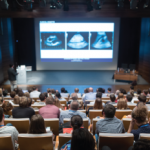 After intense academic classroom studies, University of Nebraska College of Medicine students in Omaha are able to put what they are learning in practice through the university’s Live Patient Experience (LPE) program, led by the Division of Rheumatology and Immunology. The LPE gives students real-life experience with patients and can serve as motivation to consider a career in rheumatology—one way to address the workforce shortage within the specialty, says Amy Cannella, MD, MS, RhMSUS, Gerald F. Moore Professor in Rheumatology and Rheumatology Fellowship Program director at the University of Nebraska Medical Center. “We are shameless promoters of rheumatology,” she says.
After intense academic classroom studies, University of Nebraska College of Medicine students in Omaha are able to put what they are learning in practice through the university’s Live Patient Experience (LPE) program, led by the Division of Rheumatology and Immunology. The LPE gives students real-life experience with patients and can serve as motivation to consider a career in rheumatology—one way to address the workforce shortage within the specialty, says Amy Cannella, MD, MS, RhMSUS, Gerald F. Moore Professor in Rheumatology and Rheumatology Fellowship Program director at the University of Nebraska Medical Center. “We are shameless promoters of rheumatology,” she says.
Dr. Cannella was behind a curriculum restructuring at the medical school, which resulted in the creation of the LPE.
History & Logistics
The concept of doing LPEs at the University of Nebraska College of Medicine came about when Dr. Cannella began teaching rheumatology to second-year medical students in 2014; the first LPE took place that same year. During a 2017 curriculum revision, an LPE was added for first-year medical students.
The LPEs take place during the preclinical phase of training. The LPE for first-year medical students is held at the conclusion of the musculoskeletal-integument block. Patients are selected from rheumatology, dermatology and orthopedic clinics. Because students have not yet studied organ systems in depth, the rheumatology patients included in the LPE typically have rheumatoid arthritis (RA), osteoarthritis or gout rather than a more complex rheumatic disease.
The LPE for second-year medical students takes place at the conclusion of the year, during the multi-organ system block. Having completed the study of all organ systems, students are tasked with synthesizing more complex diagnostic and therapeutic strategies. At this time, students meet patients with multi-system rheumatic disease, such as lupus, scleroderma, vasculitis, myositis and severe RA.
“They have heard the material in lecture and worked through it in the anatomy labs, hands-on POCUS [point-of-care ultrasound], team-based learning and problem-based learning cases, video games/modules and an immunology lab experience. We wrap everything up by putting a patient’s name, face and story to the diseases,” Dr. Cannella says.

A second-year medical student, Luke Siedhoff, listens intently to a patient
telling her story.
Students are divided into groups of about 13 each, and the groups rotate to different educational rooms to meet with a total of 10 patients. Each patient is there with a faculty member, often someone who is that patient’s actual doctor. That person helps facilitate discussion as needed and can answer clinical questions students may have, Dr. Cannella says.
During each session, students can ask questions and examine the patient. There’s a 15-minute time block to meet with each patient. Although students could go longer and continue to ask relevant questions, Dr. Cannella has found that 15 minutes is the sweet spot for patients. A 15-minute break occurs in the middle of the event.
The program provides food for patient participants, as well as students. There used to be a quiz after the LPEs, but Dr. Cannella found that students would get anxious about doing well on the quiz and not focus as much on the qualitative experience with the patients. Instead, students now write down five take-home points from the LPEs.
The LPEs also occurred during the COVID-19 pandemic, with a handful of virtual meetings with patients. However, both patients and students seemed to agree that the in-person option was more effective, Dr. Cannella says.
While Dr. Cannella anticipated students would gain clinical knowledge from the hands-on experience of LPEs, she did not foresee some of the other critical messages they would receive.
“I can’t tell you how formative it is for students to meet people living with the diseases they have studied, and hear [about the condition] from the patient perspective,” she says. Patients include such messages as, “No one would listen to me” and “Advocate for your patients.” Those messages are not easily teachable in medical school, and that’s where these rheumatology patients—who seem to naturally be good teachers—come in, Dr. Cannella says.
Those types of lessons are difficult to teach in the preclinical years, and at least equally important to the clinical facts reinforced during LPEs, she adds.
A Patient’s Point of View
One patient who has taken part in LPEs four times is Bobbie Owens, a Bellevue, Neb., resident living with RA since her diagnosis in 1981.
Ms. Owens has always been happy to participate in the LPEs because her husband is a high-school teacher and coach. Because of this, she likes to help students any way she can, she says.

Jackie Latka describes living with scleroderma.
During the LPEs, students touch her joints and look at where she has deformities. She walks around, bends her elbows and takes off her shoes to show her feet. One photo from an LPE shows a student gently holding her hands affected by RA.
Taking part in the LPEs is one of her favorite things to do, she says. “It helps me as a patient by giving me hope for the future. I see young people who are compassionate and willing to listen to the patient’s side,” Ms. Owens explains.
Students also show empathy by asking good questions, such as, “How do you keep going?” and “Why don’t you get more discouraged?” Ms. Owens says.
The questions surprise and delight Ms. Owens, who shared that her religious faith has played a big role in living with RA. She also wants to make sure students understand the importance of building therapeutic relationships with their patients founded on mutual respect, trust, and compassion.
A Student’s Point of View
From a student’s perspective, the LPEs play a foundational role in moving forward in their medical career, says Rebecca T. Brooks, MD, a former University of Nebraska Medical Center student and now an internal medicine resident with Mayo Clinic in Rochester, Minn.

A medical student connects with Barbara Owens, who has rheumatoid arthritis, as he
gently examines her hands.
“During the preclinical years, you don’t get a lot of face time with patients. It’s almost a motivating factor to think about how studying applies to the future,” Dr. Brooks says.
She was particularly touched to see each patient’s physician in the room with them and witness how impactful that relationship was. “They knew about their [patient’s] gout and their grandchildren,” she says.
The LPEs also bring home the importance of certain decisions that a specialist may make, whether it’s submitting a pre-authorization form or investigating a new drug for a patient. Those decisions can help patients live more fruitful lives. “Our goal is to make them functional for what they want to do, not just for their clinical disease. If they want to cycle for 20 miles, then we treat them for that,” Dr. Brooks says. “It’s not just getting their uric acid lower, it’s helping patients live their life.”
Dr. Brooks also took part in another LPE within infectious disease, although it had a different format. During that one, the medical school students listened to and asked questions of a panel of patients with HIV.
Dr. Cannella shared take-home points written by another student after the December 2022 LPE. Here’s a slightly edited version of what that student wrote:
- I learned to truly listen to the patient. They know what is going on with their body, even if the symptoms being described don’t make sense together. It may be something rare or something that is not high on the differential list.
- I learned to be patient and caring because some patients are going through life-changing diseases, and it is important to always value what they have to say. They need to know that you have their back.
- If I don’t know the answer to a clinical question or what diagnosis the patient has, it is better to be honest and tell the patient, “I don’t know” than to give them reassurance that it is probably nothing.
- No matter what specialty you’re in, you can pick up on certain things that other doctors may have missed. I heard today that a pain physician was able to detect some changes that led to a rheumatology referral, which changed this patient’s life for the better.
- I learned that rheumatology is a very interesting and fulfilling specialty! I had never considered rheumatology as a specialty I would be interested in, but these interactions have changed my mind in that regard.
Are LPEs Effective?
To examine the effectiveness of LPEs, Dr. Cannella and colleagues conducted a study published in 2020 that compared LPEs with other learning modalities for a second-year rheumatology core of 286 students.1 The other learning modalities included Augenblick (which features pictorial findings of rheumatic disease and case discussions), problem-based learning, a gout racer video game, a rheumatology remedy e-module and a simulation knee injection. Using a five-point Likert scale to rate their effectiveness, the LPE earned a mean effectiveness score of 4.77, followed by 4.21 for Augenblick, 4.11 for problem-based learning, 3.49 for the gout racer video game, 3.49 for the e-module and 3.09 for the simulation knee injection.

Dr. Cannella
In the study, the LPE was the only learning modality among the six perceived by a majority of students to be highly effective.1
One unique thing about LPE is that in today’s atmosphere of self-directed learning, asynchronous e-learning and gamification, LPE is not well represented in the literature and does not involve technology, “yet it was able to outperform the more widely accepted, technologically advanced, asynchronous and traditional active learning strategies, including problem-based learning,” the study authors wrote.1
7 Tips for LPEs
Dr. Cannella encourages other medical school/rheumatology programs to consider adding an LPE component to their curricula. Here are a few tips for those setting up LPEs for the first time.
- Think about patient selection. Look for patients who will be open and willing to share their story. Although Dr. Cannella has found patients love the LPEs once they do them, there can be some initial hesitation. “The last thing you want to do is make a patient feel uncomfortable,” she says. Still, she has yet to have a patient say no; some even take time off work to come and teach during the four-hour event. At this point, the repeat patients know each other, and many have formed friendships.
- Let patients know several months in advance. Repeat patients will ask when the LPEs will be held so they can get it on their calendars. The program currently lets them know about four months ahead of time.
- Provide students with PowerPoint information and images from patient records to review in advance. (All participants give permission for their clinical information to be shared with students.)
- Have a backup plan. Just like anything in life, someone may need to drop out due to an illness or another last-minute change of plans. The University of Nebraska College of Medicine has some faculty members with rheumatic disease, and Dr. Cannella asks them to be back-up if patients drop out unexpectedly. The program also can set up ultrasound or microscopes for hands-on use to help fill up a time slot, she adds.
- Have a few assistants or nursing staff who can help get patients and students where they need to go on the day of the LPE. The University of Nebraska LPE day uses three people to help with these logistics.
- Show your thanks. After the LPE, Dr. Cannella will send a card signed by all students and a letter to thank patients for their participation, sharing some of the feedback from students. The letter also includes a $50 gift card as a token of appreciation.
- Think about the big picture. If the prep involved with LPEs sounds like a lot, Dr. Cannella says it’s crucial to remember why it’s done. “Every year I ask myself if it is worth the effort to put this together. I always know the answer is yes when I read the comments and see the joy on the patients’ faces when they arrive, greet their friends and interact with the students. It’s a win-win,” she says.
Vanessa Caceres is a medical writer in Bradenton, Fla.
Reference
- Rohlfsen CJ, Sayles H, Moore GF, et al. Innovation in early medical education, no bells or whistles required. BMC Med Educ. 2020 Feb 7;20(1):39.


